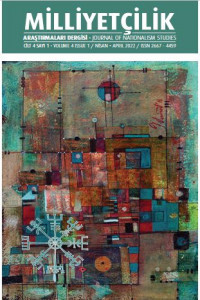DEMOKRASİSİZ HALKLARDAN HALKSIZ DEMOKRASİLERE: DAĞILAN SSCB VE SONRASI
Bu çalışmanın amacı 1985 Gorbaçov iktidarında “Glasnost” ve “Perestroyka” ile başlayıp altı yıl süren reformların ardından 1991’de dağılan Sovyet Sosyalist Cumhuriyetler Birliği’nden (SSCB) ortaya çıkan devletlerin siyasal sistemlerini ampirik demokrasinin temel niteliklerinden olan özgür, adil ve düzenli seçimlerin yapılması ile çoğunluğun yönetimi/değişebilirliği bağlamında değerlendirmektir. Çalışmanın problematiğini uzun yıllar komünist sistemle yönetilmiş bu devletlerde dağılma sonrasında hangi yönetim biçimlerinin, parti sistemlerinin tercih edildiği, demokratik gelişimin ne ölçüde sağlandığı ve bu ülkelerin siyasal sistemlerine yön veren faktörlerin neler olduğu hakkında fikir edinmek oluşturmaktadır. Betimleyici ve karşılaştırmalı tarihsel yöntemlerin bir arada kullanıldığı çalışmada kısaca SSCB’nin dağılma süreci sonrasında bölgede ortaya çıkan yeni devletlerin siyasal durumu, ortaya çıkan yeni devletlerde tercih edilen siyasal sistemler ve bunların özellikleri, bu devletlerden kaçının demokrasiye yöneldiği ve bu demokrasilerin nasıl işledikleri gibi soruların cevapları aranmaya çalışılmıştır. Araştırma sonucunda elde edilen başlıca sonuç olarak dağılma sonrası SSCB’den ortaya çıkan on beş bağımsız devletin tamamının demokratik bir siyasal sistem kurma çabası içinde olmalarına rağmen, yalnızca birkaç devletin başarılı olduğu tespiti gösterilebilir. Bir diğer sonuç olarak ise bu devletlerin büyük bölümünde yeni tesis edilmeye çalışılan bu demokrasilerde komünist sistemden miras kalan tek parti/öncü parti zihniyetinin devam etmekte olduğundan bahsedilebilir.
Anahtar Kelimeler:
SSCB, Eksik Demokrasi, İlliberal Demokrasi, Demokratikleşme
FROM DEMOCRACIES WITHOUT PEOPLE TO PEOPLE WITHOUT DEMOCRACIES: DISSOLVED USSR AND AFTERWARDS
The aim of this study is to evaluate the political systems of the states emerging from the dissolved Soviet Union in 1991, following the six-year reforms initiated by "Glasnost" and "Perestroika" during Mikhail Gorbachev's regime in 1985, in terms of conducting free, fair, and regular elections – which are fundamental attributes of empirical democracy – through to context of the majority's governance/changeability. The problematic of the study revolves around understanding the preferred forms of governance and party systems in these states, which used to be ruled by communist systems for many years, after their dissolution. It also seeks to determine the extent of democratic development and the influencing factors behind the political systems of these countries. The study employs both descriptive and comparative historical methods to investigate the political situations of the newly emerged states in the region after the collapse of the USSR. It delves into the preferred political systems in these new states and their characteristics, as well as exploring how many of these states transitioned towards democracy and how these democracies function. The main conclusion drawn from the research is that despite all fifteen independent states emerging from the dissolved USSR attempting to establish democratic political systems, only a few have been successful. Another notable result is that in many of these states, the legacy of the communist system's single-party/vanguard party mindset persists in the newly attempted democracies.
Keywords:
USSR, Imperfect Democracy, Illiberal Democracy, Democratization,
___
- Cheibub, J. A. (2012). Presidentialism, Parliamentarism and Democracy. Cambridge: Cambridge University Press.
- Colomer, J., Banerjea D. ve Mello F. (2016). “Democratization-To Democracy Through Anocracy”. Democracy&Society. 13(1): 19-25.
- Dahl, R. (2001). Demokrasi Üzerine. Ankara: Phoenix Yayınları.
- DİE (1993). Eski SSCB Cumhuriyetleri İstatistik Göstergeleri 1970-1992, Ankara: DİE Yayınları
- Dursun, D. (2008). Siyaset Bilimi. İstanbul: Beta Yayınları.
- Elgie, R. (2011). Semi-Presidentialism: Sub-Types and Democratic Performance. Oxford: Oxford University Press.
- Furman, D. (2008). “Imitation Democracies: The Post-Soviet Penumbra”. New Left Review. (54): 29-47.
- http://www.hrw.org/legacy/reports/reports98/tajikistan/ (2.7.2012).
- https://freedomhouse.org/sites/default/files/2023-02/All_data_ FIW_2013-2023.xlsx (17.7.2023).
- https://www.cia.gov/the-world-factbook/countries/russia/ (28.6.2023).
- Kapani, M. (1999). Politika Bilimine Giriş. İstanbul: Bilgi Yayınevi.
- Mounk Y. (2018), The People Vs. Democracy. London: Harvard University Press.
- Mustafalı, A. (2022). Rus Milliyetçiliği Tarihsel Süreç ve Putin. Ankara: Polietika Yayınları.
- Schedler, A. (2009). “Electoral Authoritarianism”. The Sage Handbook of Comparative Politics içinde, Ed. N. Landman ve T. Robinson, 380-393. London: Sage.
- Schmidt, M. G. (2001), Demokrasi Kuramlarına Giriş. Ankara: Vadi Yayınları.
- Schofield N., Gallego M. (2013). “La modelización de la política: Au-tocracia y Anocracia”. Nuevo institucionalismo: Gobernanza, Economía y Políticas Públicas içinde, Ed. X. C. Arias, G. Caballero, 181-204. Madrid: Centro de Investigaciones Sociológicas.
- Shugart, M. S. ve Carey, J. M. (1992). Presidents and Assemblies. Constitutional Design and Electoral Dynamics. Cambridge: Cambridge University Press.
- Zakaria, F. (1997). “The Rise of Illiberal Democracy”. Foreign Affairs. (76): 22-43.
- ISSN: 2667-4459
- Yayın Aralığı: Yılda 2 Sayı
- Başlangıç: 2019
- Yayıncı: Haluk KAYICI
